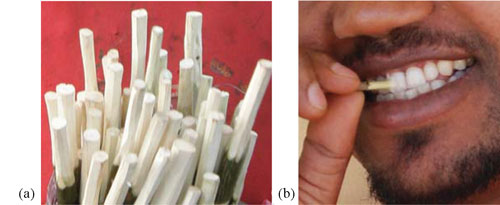How can the burden of oral diseases be reduced?
The burden of oral diseases and several other chronic non-communicable diseases can be reduced simultaneously by addressing common risk factors, such as tobacco use, harmful use of alcohol and an unhealthy diet. Therefore, the health education you should give to people in your community to promote oral health should be to:
- Reduce the intake of sugars and fats and eat a well-balanced diet, which is rich in fruits, vegetables, whole grains, peas and beans; raw vegetables and fruits also help to clean the teeth due to their high fibre content.
- Drink milk. It contains calcium to build strong teeth and bones.
- Eat fluoride-rich foods, such as fish, if they live in a low-fluoride area. Excess fluoride in water can be controlled by the authorities if water is treated to remove some of the fluoride; traditional low-cost methods include storing drinking water in clay pottery, which absorbs some of the fluoride.
- Don't smoke or chew tobacco and don't chew khat.
- Reduce alcohol consumption to small occasional amounts (if any).
- Promote oral hygiene.
Oral hygiene is the practice of keeping the mouth clean and healthy by brushing the teeth, gums and tongue every day, and cleaning between the teeth using thread-like material (flossing) to prevent tooth decay and gum disease. Advise your community members, especially children, to brush their teeth for a minimum of two minutes at least twice a day and ideally after each meal. If modern toothbrushes are unavailable or are too expensive, use indigenous tooth sticks made from neem, woiyra or other trees (Figure 6.11).

In big towns, modern toothbrushes and toothpaste are available for cleaning the teeth, but they cost much more than traditional tooth sticks. You should advise your clients that if they buy a toothbrush, choose a soft bristled one and use fluoride toothpaste. Hold the toothbrush at a 45-degree angle at the gum line, brushing in a circular motion. This sweeps plaque from between the teeth.
People living with HIV/AIDS, diabetes or cancer should ask a dentist or doctor to check their oral cavity once or twice a year, because these conditions weaken the resistance of the body and infection in the mouth is very likely.
In the next two study sessions (the final sessions in Part 1 of this Module) you will learn about how to give life-supportive care to people with emergency conditions.